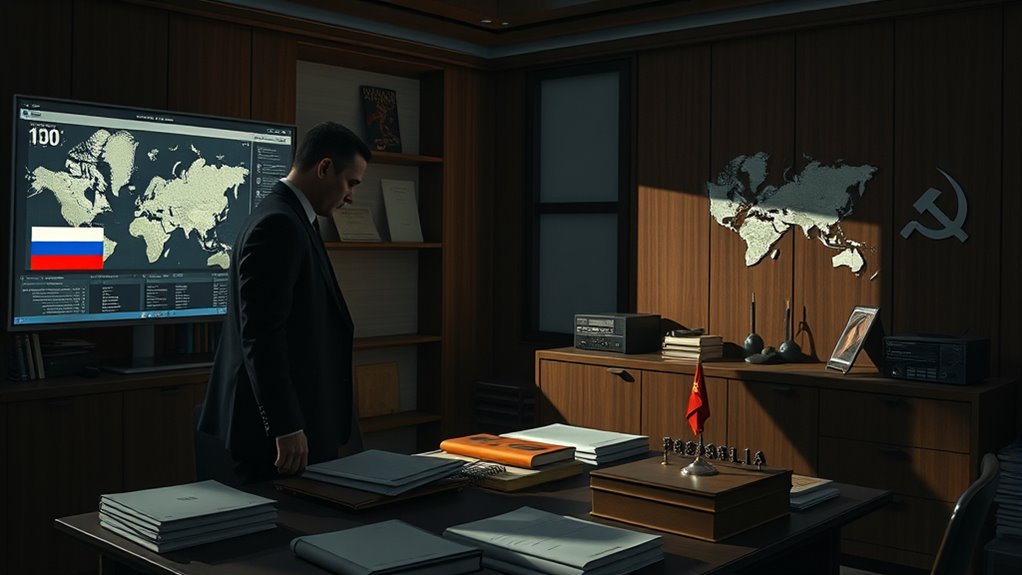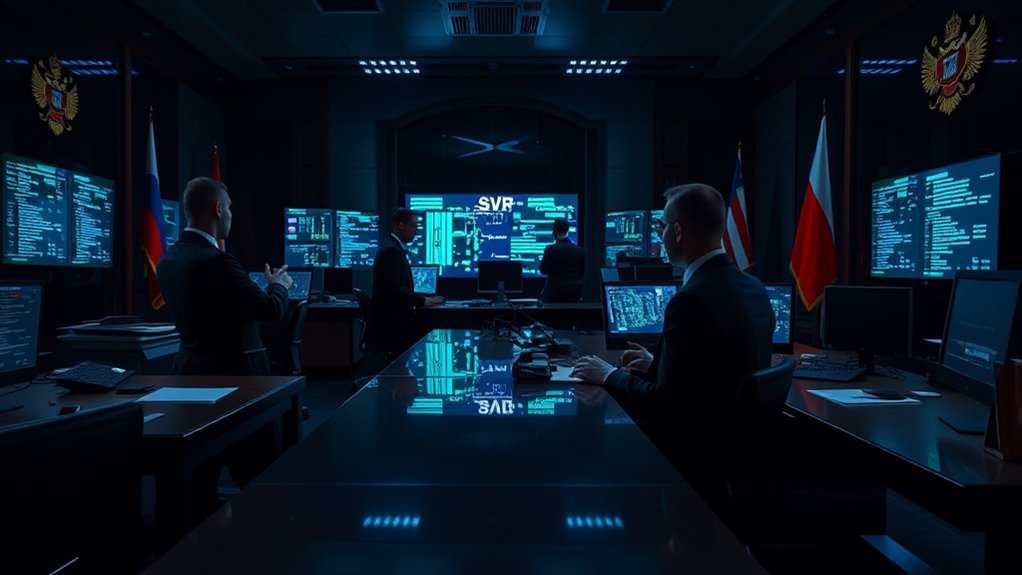Russia’s SVR operates as Moscow’s top foreign intelligence agency, deploying advanced espionage tactics to gather critical information globally. You’ll find its agents using human sources, cyber attacks, and covert communication methods like encrypted channels and dead drops. They often pose as diplomats or journalists to access targets while constantly adapting to new threats. If you stay focused, you’ll discover just how sophisticated their operations are and what makes the SVR a formidable intelligence power today.
Key Takeaways
- The SVR operates covertly, gathering global intelligence to bolster Russia’s strategic interests through advanced espionage techniques.
- It employs cover identities like diplomats and journalists, utilizing clandestine communication for secure information exchange.
- The agency integrates HUMINT, SIGINT, and cyber espionage, targeting government, corporate, and infrastructure sectors worldwide.
- SVR operatives adapt quickly to different environments, exploiting technological vulnerabilities and manipulating individuals via social engineering.
- It continuously updates its methods to stay ahead of counterintelligence efforts, maintaining a complex web of global covert operations.

Russia’s SVR, the country’s primary foreign intelligence agency, operates in the shadows, gathering information from around the globe to serve Moscow’s strategic interests. As you explore its world, you realize that the agency’s success hinges on sophisticated espionage tactics and meticulously planned intelligence operations. These tactics are designed to penetrate foreign governments, corporations, and organizations, often employing covert methods that remain hidden from the target. You see how the SVR’s operatives use a combination of human intelligence (HUMINT), signals intelligence (SIGINT), and cyber espionage to collect crucial information. Their agents might pose as diplomats, journalists, or businesspeople, blending seamlessly into foreign environments to gain access to sensitive data. This blend of cover identities allows them to execute complex operations without raising suspicion.
In the field, you notice the importance of clandestine communication methods. The SVR relies on encrypted channels, dead drops, and secret meetings to coordinate their efforts. These intelligence operations are carefully crafted, often involving multiple layers of deception to mislead adversaries. You understand that the agency’s operatives are trained to adapt quickly, using an array of espionage techniques that can shift depending on the target and context. For instance, they might exploit vulnerabilities in foreign technological infrastructure or leverage social engineering to manipulate individuals into revealing classified information. Every move is calculated, with careful risk assessment to minimize exposure and maximize intelligence yield. Additionally, the SVR continuously updates their methods to stay ahead of evolving counterintelligence efforts.
You become aware that the SVR’s approach is relentless, constantly evolving to stay ahead of foreign counterintelligence efforts. They keep pace with technological advancements, incorporating cyber operations and digital espionage into their toolkit. Hackers within the agency may target government networks, political institutions, or critical infrastructure to extract intelligence that influences Moscow’s foreign policy. Their operations are often covertly coordinated with other Russian agencies, forming a complex web of intelligence gathering that spans the globe. As you observe this, it’s clear that the success of the SVR depends on their ability to conduct seamless intelligence operations—discreet, efficient, and adaptive—ensuring Russia maintains a strategic edge in the international arena.
Frequently Asked Questions
How Does the SVR Recruit New Spies?
You’re recruited through a mix of covert recruitment strategies, often targeting individuals with valuable skills or connections. The SVR looks for vulnerabilities or motivations to persuade potential spies. Once recruited, they undergo rigorous spy training, which includes espionage techniques, languages, and operational security. This combination of strategic targeting and all-encompassing training ensures they’re prepared for the complex demands of foreign intelligence work.
What Are the Svr’s Primary International Targets?
You should know that the SVR mainly targets foreign governments, intelligence agencies, and key political figures. They focus on diplomatic infiltration to gather sensitive information and conduct cyber espionage to access critical data remotely. By exploiting diplomatic channels and digital vulnerabilities, they aim to influence foreign policies and gain strategic advantages. Their international targets are carefully chosen to maximize intelligence gains that benefit Russia’s national interests.
How Does the SVR Operate Covertly in Foreign Countries?
You might think the SVR operates openly, but it relies on covert methods like cyber espionage and clandestine communications to gather intelligence undetected. They embed agents in foreign countries, use encrypted channels, and exploit digital vulnerabilities to stay hidden. By blending into local environments and employing sophisticated technology, the SVR guarantees its activities remain clandestine, making it difficult for outsiders to uncover their true operations or intentions.
What Technologies Does the SVR Use for Espionage?
The SVR uses advanced technologies like cyber espionage tools and signal interception to gather intelligence. You’ll find them hacking into networks, deploying malware, and intercepting communications to stay ahead. They often utilize encrypted channels and covert devices to access sensitive data without detection. This combination of cyber tactics and signal interception enables them to operate discreetly and efficiently in foreign countries, ensuring Russia’s strategic interests are protected.
How Does the SVR Coordinate With Other Russian Intelligence Agencies?
You should know that the SVR orchestrates its covert operations with almost supernatural precision, especially through cyber espionage and clandestine communications. They coordinate seamlessly with other Russian intelligence agencies, like the FSB and GRU, sharing intelligence and resources behind the scenes. This network operates like a well-oiled machine, ensuring their global espionage efforts are synchronized, efficient, and almost impossible to detect, making Russia’s intelligence apparatus a formidable force.
Conclusion
As you consider Russia’s SVR today, it’s almost as if secrets and coincidences intertwine, revealing more than they hide. Each clandestine move hints at a deeper game, reminding you that behind every apparent coincidence lies a calculated strategy. In this world of shadows, what seems accidental may just be a carefully crafted piece of a larger puzzle. So, stay alert—sometimes, the truth is hidden in plain sight, waiting for you to notice the patterns.









